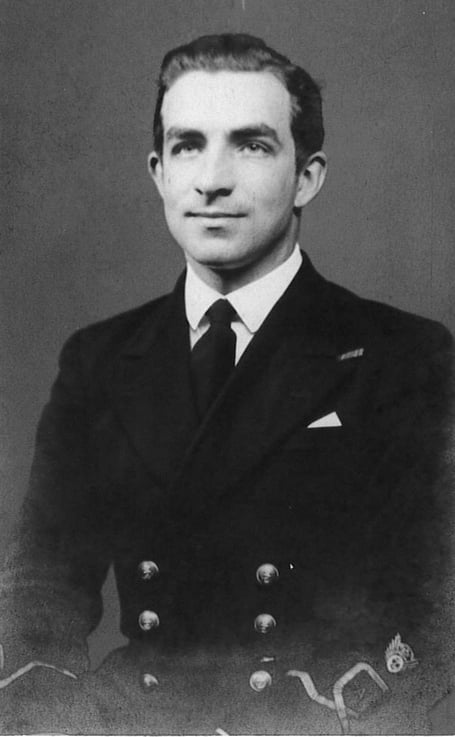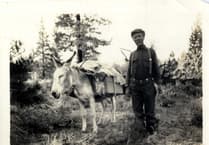Eighty years ago this week, Leading Wren Kathleen Oates turned twenty-three. Among her presents was a letter from an airman who was friendly with Cynthia, Kathleen’s counterpart in the Control Tower. Both Cynthia and the airman shared a talent for art and it appears that Cynthia had asked him to paint a picture for Kathleen as a birthday present. Instead, he chose to paint a light-hearted but vivid scenario in words, reflecting the reality of wartime flying at Ronaldsway.
Dear Miss Oates,
I don’t suppose this is what you think of when you imagine a seascape, but I suddenly had this idea, and as Cynthia has intimated that you would like a picture, I hope this will do.
If you like it please accept it in appreciation of your service on the occasions when you used to “chalk up the times for “Aimwell Fox” – and because I believe you are fairly decent to your ‘oppo”!
I call it “Land Ho!”. Imagine the last leg of a navex -
‘Hello pilot, can you see any signs of land yet?’
‘What’s that? ‘
‘Can you see the ruddy coast yet? ‘
‘No, not a thing. ‘
‘Well you should do. I’ve got it on the radar at eight miles. ‘
Silence, or rather just the usual roar of a Barracuda’s engine, mixed with bursts of R/T natter and the TAG crooning with his “mike” switched on.
Then –
‘Hello, Observer – there’s something on the port bow – have a look.‘
So the Observer takes his head out of the radar screen and tries to see clearly through the blister of scratched, grimy perspex. Then, the sun breaks through in the distance, and the low clouds at the horizon resolve themselves into something more solid, and it’s, “Land ho!”.
You feel at that moment full of high spirits and soon you’re asking for a “pancake” in a cheerful voice, thinking how good it will be to get your feet on the deck again, and to be rid of all the noise, and the smell of 100 octane fuel. Maybe there’ll be jam for tea, and a letter from home, and if night flying’s cancelled you may perhaps be able to take that girl out.
Just then you vaguely hear the pilot’s voice –
‘I say Chopper old boy, I can’t get the bloody wheels down.’
One’s dreams change rather abruptly from kisses in the moonlight, to visions of the sickbay!
Sincerely,
Chopper Chard
.JPG?trim=0,10,0,16&width=752&height=501&crop=752:501)
This author was actually Richard Chard, nicknamed ‘Chopper’ due to his degree in Forestry; he was an Observer at Ronaldsway. He had applied to join the Fleet Air Arm in 1939 but it was deferred until 1943, when he had finished studies at Edinburgh University. His training as an Observer took him to Trinidad and then back to the UK to Burscough, Lancashire before moving on to the Isle of Man in July 1945. There, he flew in Barracuda, Swordfish and Anson planes.
The ‘duty’ column in Richard’s log book listed activities on the Isle of Man such as disappearing contacts, ASH runs [involving air to surface radar], A/S bombing, local flying, low-flying over sea and wind finding, air firing, high dive bombing and live depth charge dropping, and showed that his time in the air varied from day to day – from half an hour to almost three hours.
Richard was a non-pilot aircrew Officer: his responsibility was for navigation, target spotting, and directing the pilot to the optimal attack profile. His role was to manage the aircraft's detection and weapon systems to ensure effective delivery against naval targets.
The superior visibility of an Observer’s position in the plane, allowed Richard to identify enemy shipping and potential targets for attack, as the pilot's primary focus was flying the aircraft. He would then direct the pilot on the best approach, particularly during dive-bombing runs, to achieve an effective strike.
The Barracuda plane especially, was designed with the Observer integrated into the aircraft's structure, highlighting the importance the Admiralty placed on this role. The third person flying with Richard and the pilot in a Barracuda was a rear gunner/wireless operator. However, Richard was especially proud of his association with the Swordfish, with that plane’s significant role in sinking Axis shipping, and in particular the Bismark.
.JPG?trim=0,104,0,98&width=752&height=501&crop=752:501)
He served as Sub-Lieutenant until receiving his release papers while based at Lossiemouth in December 1946: no early demobbing for him. The War didn’t pass without personal sadness as brother Peter had died of wounds at Arnhem.
Richard then joined the Forestry Commission and was married in 1950 to Pamela, who had been in the Women’s Timber Corps. They had four sons and lived in various locations across the UK, with Richard’s work ranging from the New Forest, to Norfolk and finally to Scotland, where Richard became the Assistant Conservator at Dumfries.
It was the combination of golf and trees that kept him busiest, and he was given honorary membership in recognition of all the work and advice he had given the golf club, particularly when the course was extended. By the time Richard died in 2005, the little pockets of woodland and future mighty oaks, planted under his direction, were already making a fine contribution to the landscape. His house with its view over the golf course is still in the family.
Richard was described by his son Simon as a modest, even humble, person. However, his ability to evoke the experience of wartime flying at Ronaldsway with such colour and in so few words, points to his being a quietly talented man on many fronts.


.jpg?width=209&height=140&crop=209:145,smart&quality=75)

